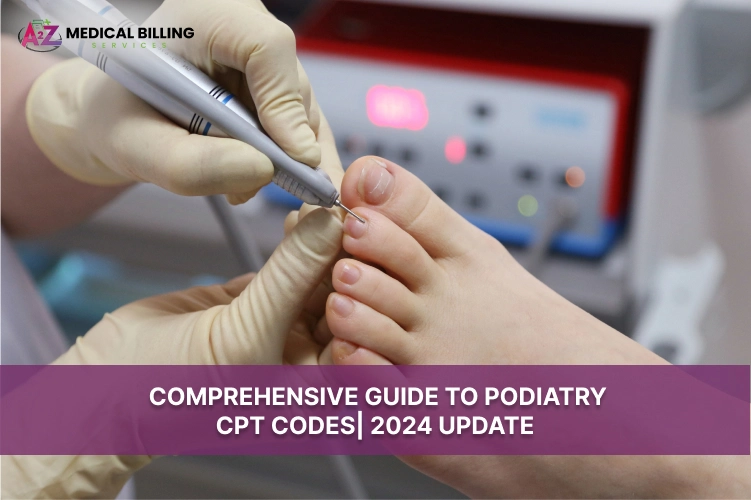In podiatry, as in all areas of healthcare, the precision of medical billing is essential for submitting accurate claims and minimizing denials.
Understanding Current Procedural Terminology (CPT) codes for podiatry CPT codes specific to podiatry ensures compliance with billing regulations and maximizes reimbursement.
CPT codes play an important role in the billing process, serving as the language that communicates the nature of care provided to insurance companies and healthcare entities.
This guide is an essential resource for podiatrists, and healthcare providers, helping a detailed look at podiatry CPT codes.
How Much Matter CPT Codes For Podiatry?
Podiatry CPT codes are standardized numeric codes that describe medical procedures and services podiatrists perform. These codes are essential in healthcare billing and compliance, ensuring that providers are reimbursed accurately.
The Role of CPT Codes in Podiatry
Podiatry CPT codes streamline the billing process by providing a uniform language that healthcare providers and insurers use to understand the medical services delivered. This standardization helps:
- Facilitate Accurate Billing: Ensures podiatrists bill for precisely what they have performed, minimizing errors. And speed up the reimbursement process.
- Enhance Compliance: Adhering to the correct CPT codes helps practices meet regulatory requirements and avoid legal issues related to billing practices.
- Improve Insurance Claims Processing: Accurate use of CPT codes reduces the likelihood of claim rejections or delays due to billing errors, leading to more consistent revenue flow.
- Optimize Reimbursements: Proper coding ensures that podiatry practices are fully compensated for the procedures they perform, reflecting the care’s complexity and resources used.
Impact of Accurate Coding on Podiatry Practices
Accurate CPT coding is more than just a billing formality; it directly influences a practice’s operational effectiveness and financial stability.
- Reduces Billing Errors: Fewer errors mean reduced back-and-forth with insurance companies and patients, leading to smoother practice operations.
- Enhances Patient Satisfaction: When billing is accurate and transparent, patients are more likely to trust their healthcare providers and feel satisfied with their care.
- Supports Data Analysis: Accurate coding provides valuable data for analyzing practice trends, identifying the most common procedures, and planning resource allocation.
Key Podiatry CPT Codes List, You Need to Know
Essential CPT codes in podiatric medicine span diagnostics, surgery, and routine care. This section provides a detailed podiatry cpt codes list within each category.
Diagnostic and Evaluation Codes
Initial assessments in podiatry utilize specific CPT codes to ensure accurate documentation and billing. Key podiatry CPT codes list include:
| CPT Code | Description |
| 99201-99205 | New patient office visits, varying in complexity |
| 99211-99215 | Established patient visits, based on service level |
Surgical Procedure Codes
Podiatric surgery codes reflect the type of surgical intervention performed. Important podiatry CPT codes listed in this category include:
| CPT Code | Description |
| 28001 | Incision and drainage of abscess of the foot |
| 28292 | Correction, hallux valgus (bunion correction) |
| 28740 | Arthrodesis, midtarsal or tarsometatarsal, single joint |
Routine Foot Care Codes
Routine foot care is critical in podiatric practice, especially for patients with chronic conditions. Commonly used podiatry CPT codes list are:
| CPT Code | Description |
| 11719 | 11719 Trimming of non-dystrophic nails |
| 11721 | 11721 Debridement of nails by any method, six or more |
H4: Common Modifiers Used in Podiatry CPT Codes
Modifiers used in podiatry CPT coding, each designed to provide additional information about the billed services:
| Modifier | Description |
| -25 | Significant, separately identifiable evaluation and management service by the same physician on the same day of the procedure or other service |
| -50 | Bilateral procedure, indicating the same procedure was performed on both sides of the body |
| -51 | Multiple procedures performed during the same surgical session |
| -59 | Distinct procedural service, indicating that services that are normally bundled into one payment were provided as separate services |
| -RT | Right side (used to specify a procedure performed on the right side of the body) |
| -LT | Left side (used to specify a procedure performed on the left side of the body) |
| -TC | Technical component, indicating only the technical part was performed |
| -26 | Professional component, indicating only the professional part was performed |
| -76 | Repeat the procedure by the same physician |
| -79 | Unrelated procedure or service by the same physician during the postoperative period |
| -GA | Waiver of liability statement issued as required by payer policy |
| -Q7, Q8, Q9 | Class A, B, or C findings, respectively, which are used for routine foot care related to systemic conditions |
Best Practices for Podiatry Coding
Podiatry coding is critical for compliance and reimbursement. This section will guide practitioners to ensure accuracy and efficacy in their coding practices.
Staying Updated with CPT Code Changes
Regular updates from the American Medical Association can significantly affect the range of procedures podiatrists can claim and how they report them. Here’s why staying informed about these updates is crucial:
Necessity of Staying Informed on Updates to CPT Codes
For podiatrists, staying current with the CPT code changes is not just beneficial; it’s essential for several reasons:
- Compliance: Changes in CPT codes can reflect shifts in regulatory requirements. Using outdated codes can lead to claim rejections and audits, potentially resulting in penalties or fines for non-compliance.
- Reimbursement: Accurate coding ensures appropriate reimbursement for services rendered. New codes can often be introduced to specify procedures better, allowing for more precise billing and potentially higher reimbursement levels.
- Clinical Documentation: Current codes help ensure that clinical documentation is precise and timely, reflecting the latest standards in patient care and medical billing.
Resources for Keeping Up with Changes
Staying informed about CPT code updates can be challenging, but various resources can help:
- AMA Newsletters and Communications: Subscribing to AMA newsletters is a direct way to receive updates from the source that authors the CPT codes. The AMA also provides resources such as webinars and training sessions on their latest changes.
- Professional Coding Organizations: The American Academy of Professional Coders (AAPC) and the American Health Information Management Association (AHIMA) offer resources, continuing education courses, and community forums to help health professionals stay updated on coding changes.
- Coding Software Updates: Many electronic health record systems and coding software are programmed to update automatically with the latest codes. Regularly checking for software updates and attending training sessions can provide insights into new features and codes.
Conclusion
In conclusion, understanding podiatry CPT codes is crucial for accurate billing, adherence to healthcare regulations, and securing proper reimbursements. Keeping current with changes in CPT codes and knowing how to apply them can significantly improve the financial stability of podiatric practices. Proper coding reduces the chances of claim rejections and boosts patient satisfaction by ensuring clear billing practices. The complexity of coding increases; ongoing education and reliable resources are essential. This guide aims to help you manage the complexities of podiatry coding effectively and confidently.
FAQs
1. What are Podiatry CPT Codes?
Podiatry CPT codes are standardized numeric labels, that represent medical procedures performed by podiatrists, essential for billing and insurance claims.
2. Why is accurate coding important in podiatry?
Accurate coding ensures proper reimbursement, and compliance with health regulations, and minimizes the risk of billing errors and claim denials.
3. How can I stay updated with changes to Podiatry CPT Codes?
Regular updates can be tracked through AMA newsletters, professional coding organizations, and updates in coding software tools.
4. What are some common modifiers used in podiatry coding?
Modifiers like -25, -59, and -RT are applied to specify details about the services provided, affecting how procedures are billed and reimbursed.
5. Where can I find resources to learn about podiatry CPT codes?
The AMA, AAPC, and AHIMA websites offer detailed resources, continuing education, and community forums to help understand and apply podiatry CPT codes.



